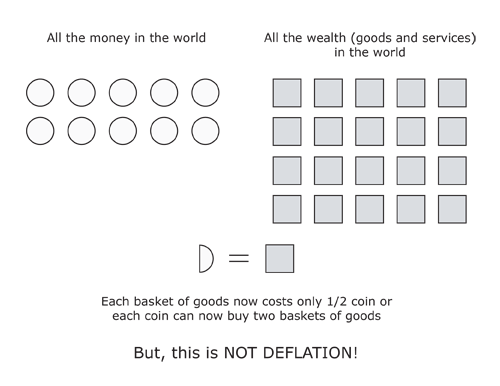It sounds strange to a lot of people that both deflation and inflation are being talked about right now as if they could possibly happen at the same time. If inflation is rising prices, and deflation is falling prices, how could they happen at the same time? In fact, there are two distict meanings for the terms “inflation” and “deflation” which are often confused and interchanged, one that is common to the average person, a general rise or fall in the level of prices, and one that is more often used by economists, a rise or fall in the amount of money in circulation. Generally the latter leads to the former, but this is not always the case. For this reason we are going to be strict with the usage of these terms in this article. We will always mean a rise or fall in the level of money in circulation.
The method of inflation in the modern world is a complicated process, but we can simplify it dramatically for the purposes of understanding it. To understand what inflation is, you must first understand what MONEY is. That might seem simple, money is the green stuff you buy your bread with, right? Yes, of course. But how it got that way is not so apparent and because of that many people take it for granted without ever understanding it conceptually.
Money is an intermediary between the output of your labor (the products that you make) and what you want to buy (the products that other people make). To understand how this intermediary developed, let’s imagine a time when there was no money. Before money people used a system of barter. For example, they would exchange beaver traps for blankets, or milk for eggs, or corn for sugar. But a problem arose whenever a person didn’t happen to have exactly what the other person needed. Eventually one item became more sought after than any other item and people realized that if they could get this item in exchange they would always be able to trade it for something else. Let’s say for the sake of an example, that this item was sugar. A person who needed eggs and had milk to exchange could find someone who needed milk to give him sugar and he could then exchange the sugar for the eggs he needed. In this example, sugar is an intermediary; sugar is money.
Sugar might really have been money at one time. It lasts pretty well in storage and people would have needed it. At various times in history many different things have been used as money, including chocolate among soldiers in WWII or cigarettes or stamps in modern day prisons. People seem to intuit the need for it and it develops spontaneously. But not all items are best suited to be money. Some problems people might have had with sugar as money, for example, is that while it lasts a long time, it can be easily destroyed by fire or water. It is relatively abundant, meaning to store up a even a moderate amount of wealth would require A LOT of it – more than a person would be able to carry around with him, or maybe even to store in his house. Eventually people came to realize that metals were uniquely suited to be money. Metals 1) store well 2) are easy to divide up into identical pieces and 3) are relatively rare so that even a little bit can store a lot of value. (Diamonds are very rare, too, but note that they do not possess benefit number 2.) Eventually gold and silver became the metals of choice for coins.
In the beginning, coins would be weighed at the time of a trade. But, eventually, governments began minting coins and vouching for their purity. The coins become known by their weight in gold or silver. An English “pound,” for instance, is the name of a weight of gold. Eventually, as people became familiar with the names, the coins were no longer weighed, but were accepted at the values stamped on their faces. This proved to be too tempting to heads of state, who were often short of funds. Because people were used to the name of the coin and no longer weighed them, the heads of state could melt down the old coins and mint new smaller coins to replace them, keeping the leftover metal for themselves. People would take the new coins just as they had taken the old ones and in this manner the King could tax his subjects without their knowledge.
What about paper money? Well, as one accumulates savings in gold or silver, it becomes increasingly difficult to secure from theft. So people came to specialize in securing other people’s gold. For a small fee, your gold would be kept in a vault and watched over. In return, you would receive a receipt showing that you were entitled to retrieve however much gold was printed on the receipt. As gold can be heavy, people began to simply exchange the receipts. In this manner, paper money came to be. (We’ll discuss paper money further in Part II of this series which discusses banking.)
Now it’s important to realize something about money. Unlike other commodities, which we all like to see become more abundant if at all possible, the ideal money is of a FIXED quantity. This is a somewhat abstract concept that can be difficult to understand at first. Bear with me and I will hopefully convince you.
We have all noticed when talking to people older than us that in general prices seem to rise over time. I remember talking to my mother and grandmother and hearing them talk about when they could go to the movies for a quarter, or buy a pair of jeans for a dollar. People often assume that it is because those who are selling their items are greedy and continually want more money for them. While it is true that people generally want more money for the items they sell, they can not dictate the price at which they are able to make a sale. Buyers and sellers must agree on a price. If the price is too high, buyers can walk away. If the price is too low, sellers can walk away. Of course, some prices actually fall over time, the prices of computers for example. But in general, prices do tend to rise over time. Why? The answer has to do with the amount of money people have to spend compared to the amount of goods and services available for people to buy. To understand this, we’ll draw some pictures.
Money is an intermediary and as such we can talk of it in terms of an entire system – i.e., the economy – meaning everyone who produces something and trades with other people. Imagine, if you will, ALL of the people in our world and all the products they’ve created that they wish to exchange with others. For the sake of illustration, we can divide all of their products into baskets that represent all of the possible goods that can be purchased and all the money that can be used to purchase them as simple gold coins.
In this example, one basket “costs” exactly one coin. But what would happen if someone discovered a new gold mine and created 10 more coins?
With 20 coins now available to purchase goods, each basket now costs 2 coins. Prices have gone up. This is INFLATION. Now lets look at the opposite phenomenon. Let’s suppose a ship carrying gold coins is lost at sea and now we only have 5 gold coins.
Now each basket costs 1/2 a coin. This is DEFLATION.
Now to be clear, lets look at what happens when the baskets change instead of the coins.
Suppose people are particularly productive one year. Everyone worked hard and produced an abundance of goods so that we now have 20 baskets instead of 10.
Again each basket is worth 1/2 a coin, but this is NOT deflation. The term deflation is sometimes used to mean “price deflation” or “falling prices” but we are not going to use it in that manner here in order to be very clear about what we are discussing.
I’m sure you can see what would happen if the opposite occurred. If an earthquake destroyed half of our baskets, each basket would be worth 2 coins. Again, this is NOT inflation.
So, to define inflation and deflation we will say they are a rise or fall respectively in the amount of money available to purchase goods. As we can see, they generally LEAD to a change in prices, but this is not necessarily so, which is why we are going to keep these terms pure. In fact, I’m sure you can already think of a situation in which inflation occurs – i.e., a rise in the volume of money available – but prices don’t change at all.
Here it is.
Now you can see why heads of state love the idea of “stable prices”!
Now, when new money is discovered or created, the new money does not affect everyone in the same way. The first person to use the new money is able to buy his goods at prices that are too low for the quantity of money.
In this example, someone is left without a basket of goods. In real life the shortage is not always as apparent as this, but it’s real nonetheless. As buyers and sellers discover the shortages, prices tend to rise. In this way the last person to use his money is hurt the most. However, let’s come back to the idea of stable prices. Suppose the people are particularly productive and the goods increase along with the money. Prices may stay the same, but the people are definitely worse off than they would have been. They are unable to enjoy the increased abundance they produced. But the idea of stable prices persists and it is particularly useful to heads of state who are generally reluctant to raise taxes. Taxes are very obvious and unpopular. But if the heads of state can manage to skim off the increases in productivity, prices stay about the same, and people never know they’ve been taxed! What a racket!
Unfortunately for the heads of state, a balance like this is hard to strike. People tend to concern themselves with the moment, thinking “I’ll worry about paying the bill later!” and heads of state are no different. Eventually the rise in prices becomes apparent, and only then do average citizens speak of “inflation.” If the rise in prices happens too fast people may decide to abandon the money altogether. This “flight to real goods” is known as “hyperinflation” and is truly a disaster that cripples a society. People suddenly have no way to keep an accounting and trade must for a time return to barter conditions.
Keep in mind that the above examples are very simplistic and are only meant to aid you in understanding the process conceptually. If this topic interests you, I recommend reading Economics for Real People by Gene Callahan as a good beginning.
But there is still the question of what’s happening today. Can inflation and deflation, in the strictest sense of the words, happen at the same time? To answer that question requires not only an understanding of what inflation and deflation are, but also how the banking system works. I cover this in the next post, The Basics: Banking, Inflation and Deflation.









2 Comments